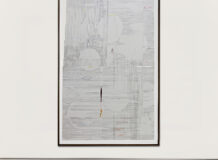The Human Condition Sustainable, by definition, refers to human actions in relation to their environment. Images generally associated with nature, the ecological, the search for balance between the space we occupy, others and ourselves come to our minds; Understanding the prevailing need to make these three factors coexist harmoniously has become a priority for decades. It is at least challenging to think about the role of art linked to sustainability, if we take as a starting point the premise – to which I adhere – that art plays a prominent role when it comes to questioning absolute truths, challenging sometimes obsolete points of view. but entrenched in the social imagination, violating spaces of comfort and motivating critical thinking and reflection in the viewer. On this occasion, the Art and Sustainability V cycle proposes to bring together a corpus of views that allude, far from any feasible obviousness, to problems related to the relationship between man and environment: they point out a possible state of situation, a scenario without humans in the foreground but present through the record bequeathed in their works. Photographs, objects, sculptures, installations, drawing and painting: a display of plastic and visual languages that project a panorama of the environment that contains us in a time – imaginary? – where the physical presence of the human hand is evident only thanks to the materiality of the works that present us with scenarios where life continues in other forms, where we realize the permanent capacity for resilience that lives in everything organic that surrounds us and that exceeds us in quantities majestic, in an other world that persists and will persist despite us. But art also sustains itself “in spite of us”… Nestor Crovetto, Gabriel Rud, Rita Simoni, Sandra Ciccioli and Luciana Fernández, trace a personal journey, propose a point of view, exercise an action that is related to everyone from a conceptual and which has little to do with nostalgia, hopelessness or transmitting a message whose purpose is to lower the line or raise awareness on the part of the viewer. If that happens, it is a product of empathy with the works and is the responsibility of the person who looks at them. His intelligent, reflective works point to a time without time where the environment “survives” us as well as the works themselves, which resist our own self-destruction. Looks that show that life is re-edited and creative sensitivity always leaves its mark. Since man is capable of generating and absorbing so much cruelty and so much love – in often disproportionate parts – art is perhaps one of the most visceral and legitimate manifestations to bear witness to our human condition, its circumstances and its consequences.
Lic. María Carolina Baulo May 2017
